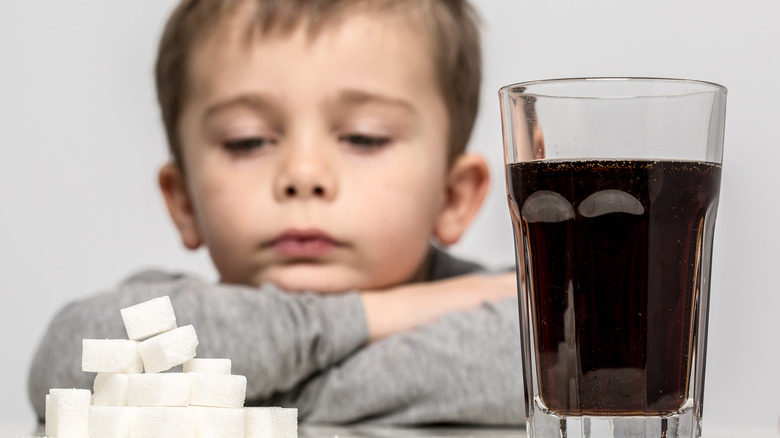How Disturbing Warning Images Could Cut Soda Consumption
Even when up against highly profitable sweetened beverages like energy drinks, sports drinks, and fruit drink products, soda remains the winner — responsible for 65% of sugary drink sales in the United States, as reported by Healthy Food America in 2018. While soda is consumed in countries around the world, a 2017 survey revealed that 28% of American respondents drink soft drinks daily, with the U.S. ranking higher in daily soft drink consumption over countries including Germany and the U.K. (via Statista).
Children, in particular, have been shown to be regular consumers of soft drinks. According to the State of Childhood Obesity, among children who are non-Hispanic white, non-Hispanic Black, Hispanic, and Asian, an average of 29.5% were reported to consume soda on any given day. Spokeswoman for the American Dietetic Association Keri M. Gans is emphatic about soda's lack of nutrients, telling Everyday Health, "It has absolutely no nutritional value. Soda is filled with sugar and calories and nothing else." For example, a 12-ounce can of Coke contains 39 grams of sugar, making up nearly the entire recommended daily average of sugar intake by the World Health Organization (WHO) of no more than 30 to 50 grams of sugar per day (via WebMD).
The health repercussions of regular soda consumption include an increased risk for diabetes, obesity, dental decay, and more (via Everyday Health). To help mitigate these risks, a recent study published in PLOS Medicine reveals how the use of cautionary images on the product label about the health risks of drinking soda may curb soda-buying behaviors in parents.
Gruesome images may curb soda-buying behaviors
Published on February 2, researchers in the study examined the shopping behaviors of over 300 parents who were instructed to buy three items — including one beverage — for their children from a simulated laboratory grocery store. In the control group, parents were exposed to sugary drink labels containing a standard barcode, while others were exposed to labels on sugary drinks containing graphic images of the detrimental effects of diabetes and heart disease on the body. It was found that nearly half of parents exposed to the traditional label purchased a sugary beverage for their child, while only 28% of parents were willing to make the purchase after seeing the warning images. These findings proved consistent across race, educational background, and socioeconomic status, regardless of their child's age.
When exploring the participants' reasoning for declining the purchase, parents cited feeling more in control of their child's eating habits, negative emotional responses to the images, and more thought given to the beverage's harmful effects, among others.
The significance of these findings indicates the potential to curb rates of health conditions related to sweetened beverage consumption among American children. Lead study author Marissa Hall elaborates, telling HealthDay, "The key is that changes to the environment in school, in stores, and what kids see on products themselves can help kids develop healthy habits that can last a lifetime."


